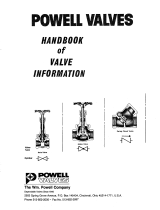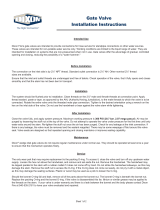Page is loading ...

6GA SERIES
MODELS 610F, 611F, 620F & 621F
IRON GATE VALVE
INSTALLATION
OPERATION
MAINTENANCE
GUIDE
DOCUMENT NO.: ES-1493
REVISION LEVEL: B
ISSUED BY: Travis Hamilton DATE: 10/7/15
APPROVED BY: _________________ DATE: _______

APOLLO
®
IRON GATE VALVE IOM GUIDE Page 2 of 7
ES1493 IOM CI Gate Valve 1418 S. Pearl Street Pageland SC USA 29728
I
NTRODUCTION
......................................................................... 3
Table 1. Apollo Series & Model Numbers ................................................................... 3
Table 2. Apollo Pipe Size (x) Designations .................................................................. 3
Table 3. Apollo Gate Valve Material Designation ........................................................ 4
Pressure/Temperature Ratings ................................................................................. 4
Product Marking ...................................................................................................... 5
Figure 1. APOLLO
Gate Valve Nameplate……………………………………………………….5
I
NSTALLATION
........................................................................... 5
Installation Instructions ........................................................................................... 5
Table 4. Iron Flange – Class 125 stud sizes ............................................................... 6
Table 5. Iron Flange – Class 250 stud sizes ............................................................... 6
Figure 2. Bolt Tightening Sequence ........................................................................... 6
O
PERATION
............................................................................... 7
M
AINTENANCE
.......................................................................... 7
Table 6. Pressure - Temperature Ratings……………………………………………….. ……...7
Table 7. Bonnet Bolt Torque ..................................................................................... 7
A
MENDMENT REGISTER
............................................................. 8

APOLLO
®
IRON GATE VALVE IOM GUIDE Page 3 of 7
ES1493 IOM CI Gate Valve 1418 S. Pearl Street Pageland SC USA 29728
6GA-10x-01
Size Code
INTRODUCTION
The APOLLO
®
Iron Gate valves covered in these guidelines are bolted bonnet, outside
screw and yoke – rising stem and inside screw – non rising stem valve types. They are
used to start or stop the flow of fluid in a piping system. The valve is operated from a
handwheel. Gate valves should always be used in the full open or full closed position.
Flow through the valve is stopped by forcing a wedge (disc) down between the tapered
seat rings.
In OS&Y rising stem valves, the gate is attached to a threaded stem with a handle that
connects to the yoke element. As the operator rotates the handle counterclockwise, the
stem rises out of the handle, opening the gate. A clockwise rotation of the handle moves
the stem back into the gate and closes the valve. When the stem is no longer protruding
beyond the handle, the gate valve is closed. The advantage of using an OS&Y gate valve is
that you can visually see if the valve is open or closed by the position of stem.
In Non-rising stem valves, the stem is held in place between the bonnet and stuffing box.
The stem threads are engaged with the internal threads of the gate. A clockwise rotation
of the handle moves the gate down the stem and closes the valve and a counterclockwise
rotation opens the valve. The advantage of using a Non-rising stem gate valve is when
there is limited space for installation.
The APOLLO
®
Iron Gate valves have approval to NSF 372 “Drinking Water System
Components” and NSF 61 “Drinking Water System Components-Mechanical Devices”.
Table 1 APOLLO
®
Series & Model Numbers
SERIES MODEL DESCRIPTION
6GA-10x 610F Class 125 Flanged Non Rising Stem, Bronze Mount
6GA-20x 620F Class 250 Flanged Non Rising Stem, Bronze Mount
6GA-11x 611F Class 125 Flanged OS&Y, Bronze Mount
6GA-21x 621F Class 250 Flanged OS&Y, Bronze Mount
x – indicates pipe size. (Reference Table 2 below)
Table 2 APOLLO
®
Pipe Size (x) Designations
Pipe
Size
Apollo
code
Pipe
Size
Apollo
code
Pipe
Size
Apollo
code
Pipe
Size
Apollo
code
2” 8 5” B 12” H
20” N
2-1/2” 9 6” C 14” J
24” P
3” 0 8” E 16” K
4” A 10” G 18” M
Example:

APOLLO
®
IRON GATE VALVE IOM GUIDE Page 4 of 7
ES1493 IOM CI Gate Valve 1418 S. Pearl Street Pageland SC USA 29728
Table 3 Apollo
®
Gate Valve Material Designation
PART MATERIAL
BODY CAST IRON (ASTM A126 CL B)
SEAT RINGS CAST BRONZE (ASTM B62)
WEDGE FACE RINGS CAST BRONZE (ASTM B62)
WEDGE CAST IRON (ASTM A126 CL B)
WEDGE NUT CAST BRONZE (ASTM B62)
STEM BRASS (ASTM B16)
BODY GASKET GRAPHITE
BOLTS CARBON STEEL (ASTM A307 B)
NUTS CARBON STEEL (ASTM A307 B)
BONNET CAST IRON (ASTM A126 CL B)
GLAND FOLLOWER BOLTS CARBON STEEL (ASTM A307 B)
STUFFING BOX GASKETS GRAPHITE
STUFFING BOX CAST IRON (ASTM A126 CL B)
PACKING GRAPHITE
PACKING GLAND CAST BRONZE (ASTM B584)
HANDWHEEL CAST IRON (ASTM A 126 CL B)
HANDWHEEL NUT DUCTILE IRON (ASTM A536 65-45-12)
WASHER CARBON STEEL (ASTM A307 B)
GLAND FOLLOWER NUTS CARBON STEEL (ASTM A307 B))
GLAND FOLLOWER DUCTILE IRON (ASTM A536 65-45-12)
YOKE CAST IRON (ASTM A126 CL B)
YOKE BUSHING CAST BRONZE (ASTM B62)
YOKE BUSHING NUT CAST IRON (ASTM A126 CL B)
SCREW CARBON STEEL (ASTM A307 B)
NAMEPLATE ALUMINUM
Pressure/Temperature Ratings
Class 125
Saturated Steam: 125 psi (8.6 Bar) to 353°F (178°C) (2”-12”)
100 psi (6.9 Bar) to 338°F (170°C) (14”-24”)
Cold Working Pressure: 200 psi (13.8 Bar) at 100°F (2”-12”)
150 psi (10.3 Bar) at 100°F (14”-24”)
CLASS 250
Saturated Steam: 250 psi (17.2 Bar) to 406°F (207°C)
Cold Working Pressure: 500 psi (34.5 Bar) at 100°F
Note: Also see Table 6 in Operation section

APOLLO
®
IRON GATE VALVE IOM GUIDE Page 5 of 7
ES1493 IOM CI Gate Valve 1418 S. Pearl Street Pageland SC USA 29728
Product Marking
All APOLLO
Gate Valves are equipped with a nameplate attached under handwheel nut
(Figure 1). This plate provides the model number, part number, size, max pressure
rating, and date of manufacture.
FIGURE 1. APOLLO
IRON GATE VALVE NAMEPLATE EXAMPLE
INSTALLATION
APOLLO
gate valves are designed for use between the faces of ANSI 125 and 250 pound
flat flanges. Proper piping alignment prior to the installation should be. Raised faced
flanges are not recommended.
Gate valves are normally installed in horizontal pipe with vertical stem.
They can also be installed other than vertical, but this may require special construction
depending on valve size, service condition and medium. For a correct operation, Conbraco
recommends that the valve stem shall be oriented inclined above horizontal, with vertical
being the preferred orientation. Different positions may cause poor valve operation,
and/or a quick deterioration of the valve. The valve should be installed with the wedge in
the closed position, to ensure that the seat ring in the wedge is not damaged during
installation.
Installation Instructions
Step 1. Check to make sure that the pipe flange and valve sealing faces are clean and
free from any debris (pipe scale, welding slag, etc.).
Step 2. Check the valve nameplate to ensure that the pressure and valve materials are
correct for the application.
WARNING! – APOLLO
®
gate valves should never be installed where service
conditions could exceed the valve ratings. Failure to heed warning may
result in personal injury or property damage.
Step 3. Place the valve between the two flanges of the pipe and put the seal gasket
between the valve flange and the pipe flange; make sure that it is correctly
positioned.
Step 4. Assemble the valve to the pipe using properly sized bolts for application. See
Tables 4 and 5 below. Progressively tighten to the torque value recommended by
the seal gasket provider. See Figure 2 for recommended method.
After the valve installation on the line and before the line pressurization, the following
activities must be performed:
- the packing bolts must be verified for tightness, DO NOT OVERTIGHTEN.
- the torque of the body-bonnet bolts must be verified for tightness
- the valve must be fully stroke operated

APOLLO
®
IRON GATE VALVE IOM GUIDE Page 6 of 7
ES1493 IOM CI Gate Valve 1418 S. Pearl Street Pageland SC USA 29728
Table 4 Stud/Bolt Iron Flange – Class 125
Valve
Size Diameter
Length Qty
(in) (mm)
2 50 5/8” 3-1/2” 4
2.5 65 5/8” 3-3/4” 4
3 80 5/8” 3-3/4” 4
4 100 5/8” 3-3/4” 8
5 125 3/4” 4” 8
6 150 3/4” 4-1/4” 8
8 200 3/4” 4-1/2” 8
10 250 7/8” 4-3/4” 12
12 300 7/8” 5” 12
14 350 1” 5-1/2” 12
16 400 1” 5-1/2” 16
18 450 1-1/8” 16
20 500 1-1/8” 20
24 600 1-1/4” 20
Table 5 Stud/Bolt Iron Flange – Class 250
Valve
Size Diameter
Length Qty
(in) (mm)
2 50 5/8” 3-3/4” 8
2.5 65 5/8” 4-1/4” 8
3 80 5/8” 4-1/2” 8
4 100 5/8” 4-3/4” 8
5 125 5/8” 5” 8
6 150 5/8” 5” 12
8 200 7/8” 5-3/4” 12
10 250 1” 6-1/2” 16
12 300 1-1/8” 7” 16
14 350 1-1/8” 7-1/4” 20
16 400 1-1/4” 7-3/4” 20
18 450 1-1/4” 8” 24
20 500
24 600
1 5 1 5
1 3 12 9
8 3
8 3
4 2 4 7
4 7
6 2
10 11
6 2
1 19
1 13 16 5
15 5
12 9
8 9
8 13
12 3
18 3
4 11
4 17
10 7
14 7
6 16
14 2 10 11
6 15
20 2
FIGURE 2. Bolt Tightening Sequence

APOLLO
®
IRON GATE VALVE IOM GUIDE Page 7 of 7
ES1493 IOM CI Gate Valve 1418 S. Pearl Street Pageland SC USA 29728
OPERATION
APOLLO
®
Iron Gate valves are intended to provide years of reliable service in an on/off
application. They are used to restrict flow when needed. They should always be operated
in a fully open or fully closed position. Gate valves are not to be used for throttling as seat
damage may result. Erosion of seats could result if throttling for extended periods of time.
Care should be taken when operating in either closed or open position for extended
periods of time. Line contamination may cause difficulty in opening or closing. A routine
cycling should be implemented depending on fluid condition and usage.
Table 6 Pressure-temperature ratings
Temperature (°F)
Pressure (PSIG)
Class 125 Iron Class 250 Iron
Sizes Sizes Sizes Sizes
2-12 14-24 2-12 14-24
-20 to 100 200 150 500 300
150 200 150 500 300
200 190 135 460 280
250 175 125 415 260
300 165 110 375 240
350 150 100 335 220
400 140 290 200
450 125 250
MAINTENANCE
APOLLO
Iron gate valves are designed for extended service with minimal wear and
servicing. Replacement parts are not available. The pipeline on either side of the valve
must be depressurized and drained prior to repair.
Valve Seat
Leakage through the valve is generally caused by foreign matter lodged in the seat seal.
This leakage can be overcome by cycling the valve or flushing. If leakage persists,
disassemble the valve and examine the seat surface on the wedge and the body. Minor
scratches can be corrected by polishing the wedge face with 400 grit sandpaper on a flat
plate. It is critical to keep the surface flat.
Bonnet Joint
Leakage through the bonnet joint may be corrected by tightening bonnet bolts. Reference
Table 7 below for recommended torque values depending on bolt size. See Figure 2 for
recommended tightening sequence. If tightening does not correct leakage, replacement of
graphite gasket will be required.
Table 7 Bonnet Bolt Torque
Bolt size 5/8”
¾” 7/8”
1” 1-1/8”
1-1/4”
1-3/8”
Torque (Ft. Lbs.)
90 150
200 300
475 660 885
Stem Packing
Leakage through the hand wheel stem may be corrected by tightening the packing nuts.
Excessive tightening may cause difficult operation of the valve. Tightness should be just
enough to stop the leak. If the packing gland screw has run out of travel, repacking
graphite gasket will be required.
Repacking of valves under pressure is NOT recommended. Even if valve is back seated
foreign matter may interfere with full closure and injury could occur.
/





